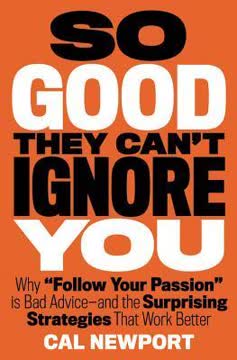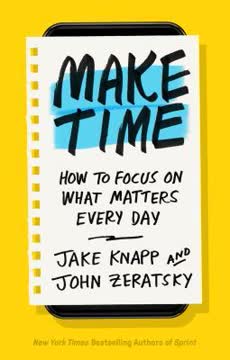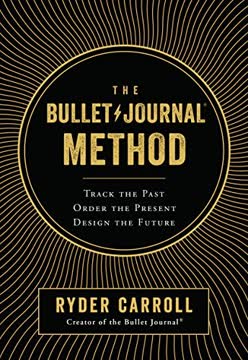Key Takeaways
1. Bullet Journal: A flexible analog system for the digital age
The Bullet Journal method's mission is to help us become mindful about how we spend our two most valuable resources in life: our time and our energy.
Analog solution for digital overload. The Bullet Journal method is a customizable organization system that helps manage tasks, events, and notes in a single notebook. It combines productivity, mindfulness, and intentionality into a flexible framework that adapts to individual needs. By providing an offline space to process thoughts, the Bullet Journal helps stem the tide of digital distractions and allows users to focus on what truly matters.
Key components of the system:
- Index: A table of contents for easy reference
- Future Log: For storing future tasks and events
- Monthly Log: An overview of time and tasks for the current month
- Daily Log: A catchall for rapid logging throughout each day
The beauty of the Bullet Journal lies in its simplicity and adaptability. Users can start with basic elements and gradually incorporate more complex features as they become comfortable with the system.
2. Rapid Logging: Efficiently capture thoughts with bullets and signifiers
Rapid Logging will help you efficiently capture your life as it happens so that you may begin to study it.
Quick notation system. Rapid Logging is the language of the Bullet Journal, designed to capture information quickly and efficiently. It uses short-form notation paired with symbols to categorize and prioritize thoughts into three main types:
- Tasks: Action items (•)
- Events: Date-related entries (○)
- Notes: Facts, ideas, observations (-)
Signifiers for context. Additional symbols, called signifiers, can be added to provide more context:
-
- (asterisk) for priority
- ! (exclamation point) for inspiration
This system allows users to quickly jot down information without interrupting their flow of thought, making it easier to stay organized and process information later.
3. Collections: Modular building blocks for organizing information
The Bullet Journal's four core Collections (Index, Future Log, Monthly Log, and Daily Log) will serve you well in most cases.
Customizable organization. Collections are the modular building blocks of the Bullet Journal, used to store related content. While the core collections provide a solid foundation, users can create custom collections for specific needs, such as project planning, habit tracking, or goal setting.
Key aspects of Collections:
- Flexibility: Can be adapted to suit various purposes
- Modularity: Can be combined or separated as needed
- Indexing: Easy to locate and reference
Custom Collections allow users to tailor their Bullet Journal to their unique requirements, making it a versatile tool for managing diverse aspects of life and work.
4. Migration: Filter out meaningless content and focus on what matters
Migration keeps you from operating on autopilot, wasting tremendous amounts of time working on things that don't add value to your life.
Regular review and transfer. Migration is the process of moving unfinished tasks and relevant information from one time period to the next. This practice serves as a built-in filter, helping users identify what truly matters and discard what doesn't.
Benefits of Migration:
- Reduces mental clutter
- Encourages regular reflection on priorities
- Prevents important tasks from falling through the cracks
By manually rewriting tasks, users are forced to consider their relevance and importance. This intentional process helps eliminate unnecessary commitments and focus energy on meaningful pursuits.
5. Reflection: Cultivate self-awareness and intentionality
Reflection is the nursery of intentionality. It grants us the protected mental environment we need to reclaim some much-needed perspective and begin to ask why.
Regular check-ins. Reflection is a crucial practice in the Bullet Journal method, encouraging users to regularly examine their progress, responsibilities, and state of mind. This process helps cultivate self-awareness and intentionality in daily life.
Types of Reflection:
- Daily Reflection: AM (planning) and PM (review)
- Monthly Reflection: During Migration
- Yearly Reflection: When starting a new notebook
Through consistent reflection, users can identify patterns, gain insights, and make informed decisions about how to allocate their time and energy. This practice helps bridge the gap between actions and beliefs, leading to a more intentional and meaningful life.
6. Goals: Break down aspirations into actionable steps
Goals give us the opportunity to define what we want.
Strategic goal-setting. The Bullet Journal method emphasizes setting meaningful goals and breaking them down into manageable steps. This approach helps users turn vague aspirations into concrete actions.
Goal-setting process:
- Identify meaningful goals based on personal values
- Break goals into smaller "Sprints" (self-contained projects)
- Create actionable tasks for each Sprint
- Track progress and adjust as needed
By focusing on fewer, more meaningful goals and breaking them into smaller, achievable steps, users can make steady progress and maintain motivation over time.
7. Mindfulness: Find meaning in the mundane and practice gratitude
Meaning can reveal itself in the most unremarkable, unpredictable, and quiet of moments.
Present-moment awareness. The Bullet Journal method encourages mindfulness by prompting users to pay attention to their daily experiences and find meaning in everyday moments. This practice helps cultivate a deeper appreciation for life and increases overall well-being.
Mindfulness techniques:
- Gratitude logging: Regularly noting things to be thankful for
- Clarity logging: Reframing mundane tasks to highlight their purpose
- Intentional reflection: Examining experiences for deeper meaning
By incorporating these practices into the Bullet Journal, users can develop a more mindful approach to life, leading to increased satisfaction and a greater sense of purpose.
8. Time management: Increase productivity through focused attention
The quality of our time is determined by our ability to be present.
Strategic time allocation. The Bullet Journal method emphasizes the importance of using time effectively by focusing on what truly matters. By prioritizing tasks and allocating focused attention, users can increase productivity and achieve better results.
Time management techniques:
- Time boxing: Allocating specific time slots for tasks
- Prioritization: Identifying and focusing on high-impact activities
- Flow state: Creating conditions for deep, focused work
By becoming more intentional about how time is spent, users can maximize their productivity and make meaningful progress towards their goals.
9. Control: Focus on what you can change and let go of the rest
We can't control the world or people around us, but there is something we can control, and it's powerful.
Stoic approach. The Bullet Journal method incorporates Stoic philosophy by encouraging users to focus on what they can control and let go of what they can't. This mindset helps reduce stress and increase effectiveness in daily life.
Areas of control:
- Responses to situations
- Personal actions and choices
- Attitude and perspective
By directing energy towards controllable factors, users can reduce frustration and make meaningful progress in their lives, even in challenging circumstances.
10. Endurance: Embrace imperfection and continual improvement
Embracing our imperfection puts the emphasis back where it should be: continual improvement.
Growth mindset. The Bullet Journal method promotes a mindset of continual improvement and embracing imperfection. This approach encourages users to focus on progress rather than perfection, leading to sustained growth and resilience.
Key principles:
- Kaizen: Making small, incremental improvements
- Wabi-sabi: Finding beauty in imperfection
- Iteration: Regularly refining processes and approaches
By adopting this mindset, users can maintain motivation, overcome setbacks, and make consistent progress towards their goals over time.
Last updated:
FAQ
What's "The Bullet Journal Method" by Ryder Carroll about?
- Overview: "The Bullet Journal Method" is a guide to a productivity system that combines organization, mindfulness, and intentionality. It helps users track their past, order their present, and plan their future.
- Purpose: The book aims to help readers become more organized and mindful by using a simple notebook to capture thoughts, tasks, and events.
- System and Practice: It introduces a system of rapid logging and collections, and a practice of reflection and goal setting to enhance productivity and personal growth.
- Community and Flexibility: The method is adaptable to individual needs and has a supportive community that shares various ways to customize the system.
Why should I read "The Bullet Journal Method"?
- Improve Organization: The book offers a structured yet flexible approach to organizing tasks and thoughts, which can help reduce overwhelm and increase productivity.
- Mindfulness and Intentionality: It encourages readers to be more mindful and intentional with their time and energy, leading to a more meaningful life.
- Personal Growth: By reflecting on past actions and setting clear goals, readers can foster personal growth and self-awareness.
- Community Support: The Bullet Journal community provides inspiration and support, making it easier to adopt and adapt the method to personal needs.
What are the key takeaways of "The Bullet Journal Method"?
- Rapid Logging: A quick and efficient way to capture tasks, events, and notes using symbols and short sentences.
- Collections: Modular building blocks that organize related information, such as daily logs, monthly logs, and custom collections.
- Reflection and Migration: Regularly reviewing and migrating tasks to focus on what truly matters and discard distractions.
- Intentional Living: Encourages living with purpose by aligning actions with personal values and goals.
How does the Bullet Journal system work?
- Rapid Logging: Uses symbols to categorize entries into tasks, events, and notes, making it easy to capture and prioritize information.
- Collections: Core collections like the daily log, monthly log, and future log help organize tasks and events over different time frames.
- Indexing: An index at the beginning of the journal helps locate content quickly, making it easy to reference past entries.
- Customization: Users can create custom collections to suit their specific needs, allowing the system to evolve with them.
What is Rapid Logging in the Bullet Journal Method?
- Core Technique: Rapid Logging is the language of the Bullet Journal, using symbols to quickly capture and categorize thoughts.
- Symbols: Tasks are marked with a dot, events with a circle, and notes with a dash, providing context and priority at a glance.
- Efficiency: This method saves time and helps users stay organized by distilling information into concise entries.
- Flexibility: Users can customize symbols and signifiers to suit their personal needs and preferences.
How do Collections work in the Bullet Journal Method?
- Modular Structure: Collections are templates that organize related information, such as tasks, events, and notes, into coherent groups.
- Core Collections: Include the daily log, monthly log, future log, and index, which form the foundation of the Bullet Journal.
- Custom Collections: Users can create their own collections for specific projects or goals, allowing for personalization and adaptability.
- Dynamic Use: Collections can be added, modified, or removed as needed, making the system flexible and responsive to changing needs.
What is the purpose of the Index in the Bullet Journal?
- Content Locator: The Index helps users quickly find specific content within their Bullet Journal by listing topics and page numbers.
- Dynamic Organization: It allows for non-linear organization, enabling users to add new entries and collections without disrupting the flow.
- Subcollections: Users can create subcollections for complex projects, which are also indexed for easy reference.
- Threading: A technique to link related content across different pages or notebooks, enhancing the journal's navigability.
How does the Bullet Journal Method encourage intentional living?
- Reflection: Regular reflection helps users evaluate their tasks and goals, ensuring they align with personal values and priorities.
- Goal Setting: The method emphasizes setting meaningful goals based on curiosity and personal experience, rather than external expectations.
- Mindful Action: By focusing on what truly matters, users can reduce distractions and make more deliberate choices.
- Personal Growth: The practice of intentional living fosters self-awareness and personal development, leading to a more fulfilling life.
What are some best practices for setting up a Bullet Journal?
- Start Simple: Begin with the core collections—daily log, monthly log, future log, and index—to get familiar with the system.
- Customize Gradually: As you become comfortable, introduce custom collections and symbols to tailor the journal to your needs.
- Consistent Reflection: Regularly review and migrate tasks to maintain focus on priorities and discard irrelevant items.
- Community Engagement: Explore the Bullet Journal community for inspiration, support, and new ideas to enhance your practice.
How can the Bullet Journal Method help with personal growth?
- Self-Reflection: Encourages regular reflection on actions and goals, fostering self-awareness and understanding.
- Goal Achievement: Breaks down goals into manageable tasks and sprints, making it easier to track progress and stay motivated.
- Learning from Experience: By documenting successes and failures, users can learn from their experiences and apply insights to future endeavors.
- Empowerment: The method empowers users to take control of their lives by aligning actions with personal values and aspirations.
What are some common challenges when starting a Bullet Journal, and how can they be overcome?
- Overwhelm: Start with the basics and gradually introduce new elements to avoid feeling overwhelmed by the system's flexibility.
- Consistency: Set aside regular times for reflection and journaling to build a consistent habit and maintain momentum.
- Perfectionism: Embrace imperfection and focus on functionality over aesthetics to prevent getting bogged down by appearance.
- Adaptability: Be open to adjusting the system to better suit your needs, and seek inspiration from the community for new ideas.
What are some of the best quotes from "The Bullet Journal Method" and what do they mean?
- "Productivity is about getting more done by working on fewer things." This emphasizes the importance of focusing on meaningful tasks rather than being busy with many.
- "Happiness cannot be pursued, it can only ensue." Suggests that happiness is a by-product of living a meaningful life, not a direct goal.
- "Intentional living is the art of making our own choices before others’ choices make us." Highlights the importance of being proactive in decision-making to align with personal values.
- "The long way is the short way." Encourages taking the time to reflect and plan, as it leads to more effective and efficient outcomes in the long run.
Review Summary
The Bullet Journal Method receives mixed reviews. Many praise its organizational system and mindfulness approach, finding it helpful for productivity and self-reflection. Critics argue the book is overly long and repetitive, with some viewing it as a cash grab. Readers appreciate the flexibility and customization of the method but are divided on the book's philosophical content. Some find the author's writing style engaging, while others find it pretentious. Overall, the book is seen as a useful guide for those interested in bullet journaling, though some suggest online resources suffice.
Similar Books





Download PDF
Download EPUB
.epub digital book format is ideal for reading ebooks on phones, tablets, and e-readers.




